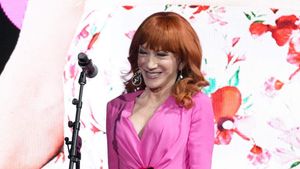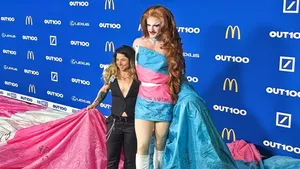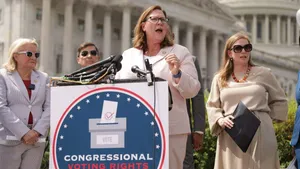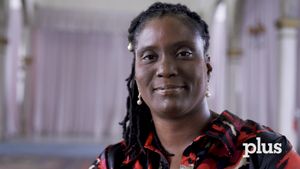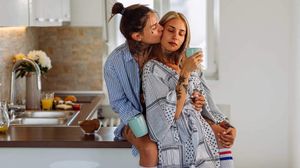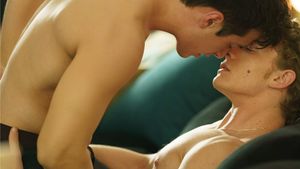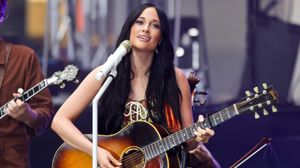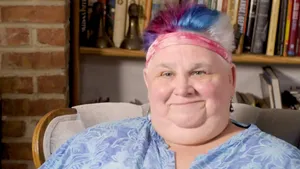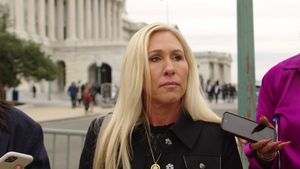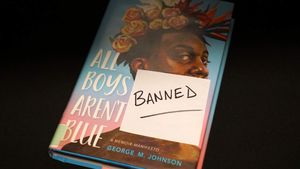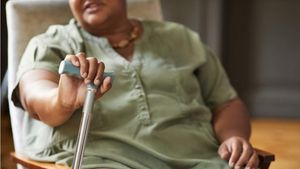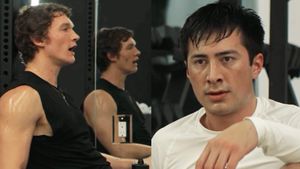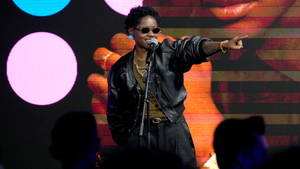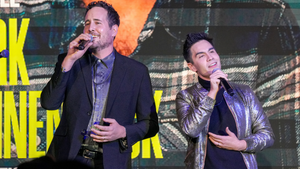CONTACTCAREER OPPORTUNITIESADVERTISE WITH USPRIVACY POLICYPRIVACY PREFERENCESTERMS OF USELEGAL NOTICE
© 2025 Pride Publishing Inc.
All Rights reserved
All Rights reserved
By continuing to use our site, you agree to our Privacy Policy and Terms of Use.
It was our first day in Edinburgh, and we were fighting jet lag with a plodding hike up Princes Street. On our southside ran the classic cityscape that spans every local postcard: the medieval turrets of Old Town, rising to the castle that looks primordial, like an organic outcrop whittled from volcanic stone. On our north side swept the softer stones of New Town, all dandified Georgian crescents and terraces. In front of us, though, history met its downfall: Princes Street, the city's great divide, is lined with mall-ready chain stores. But even a street this defeated couldn't defy Scottish soul. Ignoring the fast-food outlets and souvenir mills, striding purposefully past all those psychedelic tartans imported from Hong Kong that no clan ever wore, there came someone unexpected. He was a craggy-faced man in his 50s with cheeks reddened by the bracing Highland air, or maybe just lots of Scotch whiskey. He walked with the brisk pace of a confirmed mountain hiker. And swirling around his sturdy Paul Bunyan legs was a forest-green kilt as manly as any sports cup and nothing like Britney drag. In a world subdued by Ronald McDonald, here, finally, was the real McCoy.
Or maybe the real MacKay, MacDougall, or Mackenzie. It didn't really matter. What mattered was the man's aura of sheer authenticity and self-conviction. It was a fitting first sight. That's because Edinburgh itself exudes the same spirit. The capital felt like the kind of town that knew how to hold firm to its own indelibly Scottish split personality. Call it half brawny and half elegant; half Braveheart and half Miss Jean Brodie; half diehard independent (a trait that has paid off in the recent formation of a Scottish parliament and the defeat of the United Kingdom's notorious Clause 28, which outlawed the "promotion" of homosexuality) and half dedicated to the most delicate etiquette.
The Scottish brogue may be the best key. A kind of seduction in itself, it starts at the back of the throat with a primal growl and then slowly moves to the front, building a musical lilt so the words roll out with a lyrical flourish. Like the city, it's half butch and half fem. My mate Tom McGhee and I found the butch half too baldly homoerotic to resist. It was those kilts again and the flash of strapping legs, the tireless mystery of what's hiding out under those manly wraparounds, that turns even the most beetle-browed Scotsman into beefcake, if only because it takes a real braveheart to strap on the skirt.
Where to see more of this cocky flair in action? We discovered the manly man's Edinburgh concentrated along the city's original rocky spine, the Royal Mile, which rises to Edinburgh Castle and descends to the Palace of Holyroodhouse. In between the two landmarks are the snaking alleys where body snatchers hid; and the tall, jagged tenements that date back to medieval times, when most of the natives clung to this bony perch, stuffed 10 to a room, pissing out the windows. The resulting slum--known as Auld Reekie--was true to the Old Town's frontier roots as a defensive center. Accordingly, the castle, watching over the town like a legacy, is no prissy Camelot. The fortress, which catches every Highland breeze, still feels like a raw, cobbled outpost despite its collection of rapper-worthy royal jewels.
So does the 16th-century Palace of Holyroodhouse, which does even better at evoking a history that's all bloodletting and strewn body parts--starting with Braveheart's own heart, which seems to have been tossed around like a month-old haggis from one tourist site to another. The ubiquitous organ's only real rival is Mary, Queen of Scots, who pops up at every historic landmark in Scotland that Braveheart's heart somehow missed. So it's no surprise that she casts her shadow over Holyroodhouse--a palace mostly famous as the killing field where Mary's Italian secretary, David Rizzio, was stabbed 56 times by jealous courtiers. According to our guide Robert, an underemployed actor who clearly faced a future of minor dinner theater, Rizzio was left looking like a "cored apple" after the classic case of overkill--but our tour wasn't complete until Robert reenacted most of the 56 puncture wounds. Perhaps the saddest landmark is an art-nouveau witches' fountain in the middle of the Royal Mile, which commemorates the 300 women--mostly widows, spinsters, and the suspiciously manless, some presumably lesbians--who were burned on the site.
For something more upbeat we headed to Edinburgh's Georgian New Town, which was built when the city's 18thcentury dandies had had enough of slumming it. A style statement from the start, New Town's neoclassical terraces and townhouses--all swirling, whitewashed columns--are the graceful antidote to Old Town's rawboned burliness, and the area offers its own more elegant cultural attractions.
First we circled Charlotte Square, architect Robert Adam's opus, and then traipsed through a Georgian house where each refurbished 18th-century room came guarded by a genteel gray-haired docent clinging with a weightlifter's grip to her black purse. Later, we studied the faces in the Scottish National Portrait Gallery, where the painting of a Bonnie Prince Charlie justified his nickname. For women, the National Gallery of Scotland offers more interesting artistic pinups, including the recently purchased statue of the three graces by Canova and a showing of strong female artists. But the city's real emerging gem is a cycle of restored murals by Phoebe Anna Traquair, a leader of the Scottish Arts and Crafts movement who worked for eight years on the luminous murals in Mansfield Place Church.
If New Town's bounty reveals Edinburgh's softer-cultured past, it also points to its stylish present too: Fittingly, the neighborhood that started as a fashion statement remains the city's trendsetter. George Street comes lined with boutiques, and the ne?est landmarks of swinging Edinburgh are clustered here. That means style queens are going to feel a lot more comfortable in New Town's urbane outposts than the boozy, backslapping pubs of Old Town. We sampled the best of the neighborhood's latest claims to hipster status, starting with a night at the Glasshouse Hotel, a Wallpaper-worthy designer hotel where the guest rooms featured plasma TVs and retro mod decor. Back on nearby George Street there was a profusion of cutting-edge pan-Asian tapas-sushi bars dishing up little snacks drunk on truffle oil. But we preferred the Dome, a refurbished bank turned bistro featuring an epic domed ceiling and a menu that roams around the world but wisely returns home for dessert. The kitchen's real pride are its old-school British sweets, especially a sticky toffee pudding that makes cr?me br?l?e look like the soupy, deflated flan that it is.
If New Town is the style queen's natural haunt, its
eastern edge--the area around Broughton Street and the top of Leith Walk, dubbed
the "Pink Triangle"--is also, naturally, ground zero for even clueless gays.
This is Edinburgh's combination Chelsea, Castro, Soho, and down-low. The area's
relatively small size means you can sample just about every local homo landmark
in a short day and long night, which we did, toward the end of our Edinburgh
weekend while on a quick all-queer tour. Georgy Boy, the entertainment manager
at CC Blooms, was our first host. The city's core gay club, Blooms is a double-decker
hangout. The second floor is given over to a bar and revolving entertainment
(cabaret, karaoke, drag), but the first floor was pure, unapologetic disco,
from the disco ball to the frosted mirrors and the DJs who favored diva pop
(read: Kylie Minogue, the Sugar Babes). What was more surprising, to our American
eyes, was the mixed crowd.
"Ninety percent of gay clubs in Edinburgh
are a mix of gay men and women," Georgy Boy says. "That's true of most of Broughton
Street. We're next to a whole row of gay clubs, including Planet Out, which
is one of the few lesbian-oriented bars, though boys are of course welcome."
What to avoid? Georgy warns that certain parts of Leith (the port district)
are questionable, especially the backstreets. At least one Leith venue is the
area's newly hot club, however: The Complex hosts a variety of gay events, including
the relaunched women's-only Velvet Night (the first Saturday of every month--the
recent debut party featured girls juggling fire sticks and shadow dancers in
hot pants).
The ghettoized sense of the Pink Triangle seems at odds with Edinburgh's open spirit, though most gays we talked to thought the densely packed homo zone was more a matter of convenience than discrimination. "Edinburgh is a very tolerant, easygoing city," says Jane Hamilton, a journalist who writes about Edinburgh's queer scene for the periodical The List. Her top local gay picks: the Regent, the Laughing Duck, Planet Out, and CC Blooms for clubs; Sala and the Blue Moon Cafe for caf?s; Wiggle, Taste, and especially Joy for club nights.
If there is at least some appearance of a queer ghetto, those doors blow wide open in August with the Edinburgh International Festival. A dense explosion of theater, dance, musical performances, and art exhibitions, the festival has morphed into a world-class cultural happening, and the influx of gay performers and art enthusiasts turns the whole city into a monthlong queer party. "The city changes completely," says Paul Robertson, who works for the Gay Men's Health Center. "The bars are jammed and all of Edinburgh becomes this cosmopolitan gay center." What helps also is the festival's decidedly queer slant (Stephen Fry, drag queen Lily Savage, Germaine Greer, Eddie Izzard, and others have played it), the growing International Film Festival (where My Beautiful Laundrette first scored big), the Edinburgh International Book Festival, and the newly launched Festival Erotique.
The traffic jam of events is a bonus, but you don't have to limit your visit to summer or to the Pink Triangle. There is something about the Scottish character, as Hamilton noted--its humor, understatement, and penchant for eccentricity--that makes for a relaxed understanding of gays and lesbians, even outside the triangle, even in low season. What helps as well is the Scottish sense of kinship: No one wants to queer-bash a fellow clansman or woman, and there was never much time to attack each other when, historically, the Scots had to save their muscles for fighting off invaders. The gays return the affection with an unexpected strain of patriotism and traditionalism. One of the biggest local gay events, held annually in February and October, is the cei?idh--a Gaelic singing and country-dancing party sponsored by the Lothian Gay and Lesbian Switchboard. The assembly rooms that hold the party are filled with women and men who know how to pull off a kilt on the inevitably sold-out nights.
Which brings us back to the beginning, and those kilts. On our last day in town we broke down and did what every sheepish visitor to Edinburgh does after they've downed the haggis. First we went looking for family crests. Just as I suspected, there was no McKadushin clan of Russian Jews hiding out in some glen, manning a smoked whitefish stand. But Tommy's own MacKay family crest surfaced in all the souvenir shops, emblazoned on everything from T-shirts to mugs. The design itself, though, was disappointing. The raised MacKay fist holding a lethal-looking sword hinted at a clan of cheap mercenaries or casual serial killers. We moved on to the tourist's second inevitable embarrassment: the search for the family tartan.
The odyssey led to Geoffrey Tailor on the Royal Mile, a family-run business that has been churning out tartan kilts for generations. The off-the-peg number I grabbed, dyed the ethereal purple of Highland heather, didn't have the expected effect. Yet Tommy looked so good in his own generic blue-and-green skirt that we decided to invest in a made-to-measure kilt sewn from his own MacKay clan tartan. That meant real money ($840 to $1,180) and a wait, so we sated ourselves with a second ready-made kilt we could take home while Geoffrey fashioned the real thing. The choices were legion; Howie, Geoffrey's son, has designed 21st-century kilts in denim, camouflage cloth, and imitation leather. Tommy, nonetheless, like a true MacKay, settled on the more staid tartan he first modeled.
"I'll take a sporran too," he told the clerk as he ducked out for a second onto the street, to join the other MacSomethings who were still bravely flashing some leg down the Royal Mile and up Princes Street like warriors who were never going to settle for the sheer banality of pants.
Planning travel to Edinburgh or elsewhere in Scotland? Check out ScotsGay Magazine and Britain Inside & Out.
RESTAURANTS
While you can still find a "wee pot of haggis,
neeps, and naps" (don't ask), Edinburgh chefs are now turning out a full range
of global cuisine and fresh seasonal dishes that do justice to the local harvest.
Inexpensive: Filmhouse Cafe-Bar (88 Lothian Rd.; +44-131-229-5932)
attracts an arty gay-friendly crowd. Blue Moon Cafe (36 Broughton
St.; +44-131-556-2788) is the city's most comfortable gay hangout and diner.
Henderson's (94 Hanover St.; +44-131-225-2131) is a vegetarian
caf? that does right by its chickpea curry and leek pie. Cafe Florentin
(8 Saint Giles St.; +44-131-225-6267) is the place for Parisian-inspired desserts.
The Dome (14 George St.; +44-131-624-8624) makes for a theatrical
lunch spot and the place for British puddings. Moderate/Expensive: The Witchery
by the Castle (352 Castlehill; +44-131-225-5613) features a gilded candlelit
dining room that claims to be haunted, though there's nothing eerie about the
kitchen's Scottish salmon and venison. The Atrium (10 Cambridge
St.; +44-131-228-8882) offers ambitious cuisine in a hybrid setting: Call it
high-tech meets harem room meets hacienda. Henry's (19 Shore
Place; +44-131-555-6625) is a romantic creative kitchen (think foie gras with
a gingerbread crust).
NIGHTLIFE
CC Blooms (Greenside Place;
+44-131-556-9331) sits at the center of the Pink Triangle and is the town's
best full-service disco. Newtown (26b Dublin St.; +44-131-538-7775)
is a brave new world where every type will feel at home. Taste (Wilkie
House, Cowgate; +44-131-225-2935) is the city's only Sunday night clubbing choice
and attracts a raucous mixed crowd. Tackno (Club Mercado, Market
St.; +44-131-226-4224) specializes in diva music and theme nights (also try
Space Age) the last Sunday of every month; Eye Candy, in the same location,
takes place every other Saturday from 11 p.m. to 4 a.m. and features glam crowds
and techno-trance. Planet Out (6 Baxter Pl.; +44-131-524-0061)
is one of the few bars that favors women over a mixed gay crowd.
The information in this story was accurate at the time of publication. We suggest that you confirm all details directly with the establishments mentioned before making travel plans. Please feel free to e-mail us at update@outtraveler.com if you have any new information.
From our Sponsors
Most Popular
Just in Time for Pride – The 15 Gayest Cities in the World in 2023
April 12 2023 6:47 PM
The 13 Least Visited National Parks
January 07 2023 5:00 AM
Get Soaked! with These 35+ Steamy Pool Pics From This Year’s White Party
May 25 2023 9:29 AM
20 Thirsty Pics of #SniffiesRush Campaign Celebrating Frat Life
December 16 2022 3:19 PM
25 Thirsty Pool Party Pics from White Party Palm Springs 2022
April 14 2023 5:55 PM
Sniffies Reveals Horniest Cities
December 22 2022 4:15 PM
15 Thirsty Pics of Moot Lingerie for Men
March 21 2023 7:41 AM
The 7 Best Nude Beaches for Gays in the U.S.
June 09 2022 4:00 AM
The Most Dangerous (& Safest) Countries for LGBTQ+ Travel
March 22 2023 5:00 AM
Outtraveler: Featured Video
Latest Stories
A gay solo traveler goes bear-hunting in Barcelona
November 13 2025 4:31 PM
More than a month: Prioritizing LGBTQ+ health year-round
October 15 2025 12:27 PM
UNITY at Sphere is the perfect Las Vegas attraction for gay tourists
October 03 2025 5:09 PM
Malta is the secret Pride destination where gays are going wild
September 18 2025 4:47 PM
What is a Jubilee? These Catholics just became the first LGBTQ+ people to participate
September 08 2025 12:49 PM
Marriage equality will be banned in these 31 states if Obergefell is overturned
September 08 2025 10:40 AM
Explore the camp, parties, and parade of Provincetown Carnival 2025
September 05 2025 7:03 PM
My big gay Broadway summer
August 27 2025 9:27 AM
Explore Zurich with Swiss style icon Susanne Bartsch
August 25 2025 9:46 AM
Splash House is the secret Pride festival where gays can truly let loose
August 22 2025 9:00 AM
When love sinks, set sail for the Hudson Navigator
August 15 2025 6:00 AM
Need an escape from American anxiety? Consider Colombia.
July 16 2025 11:47 AM
This heavenly hotel in the heart of Hell's Kitchen is the perfect oasis
June 26 2025 6:00 AM
Top 10 LGBTQ+ beach towns perfect for Pride and summer fun
June 05 2025 1:54 PM
Checking out: nhow London, the city’s coolest hotel
June 02 2025 8:45 AM
Cruising the world helped this gay couple find lasting love
May 31 2025 2:45 PM
Gays went feral at an iconic Pride celebration in Pensacola, Florida
May 30 2025 6:00 AM
Wilderness, woods, and Wigstock: Drag icons light up the Catskills
May 28 2025 12:17 PM
Out and About with Christian Cooper
May 28 2025 11:07 AM










































